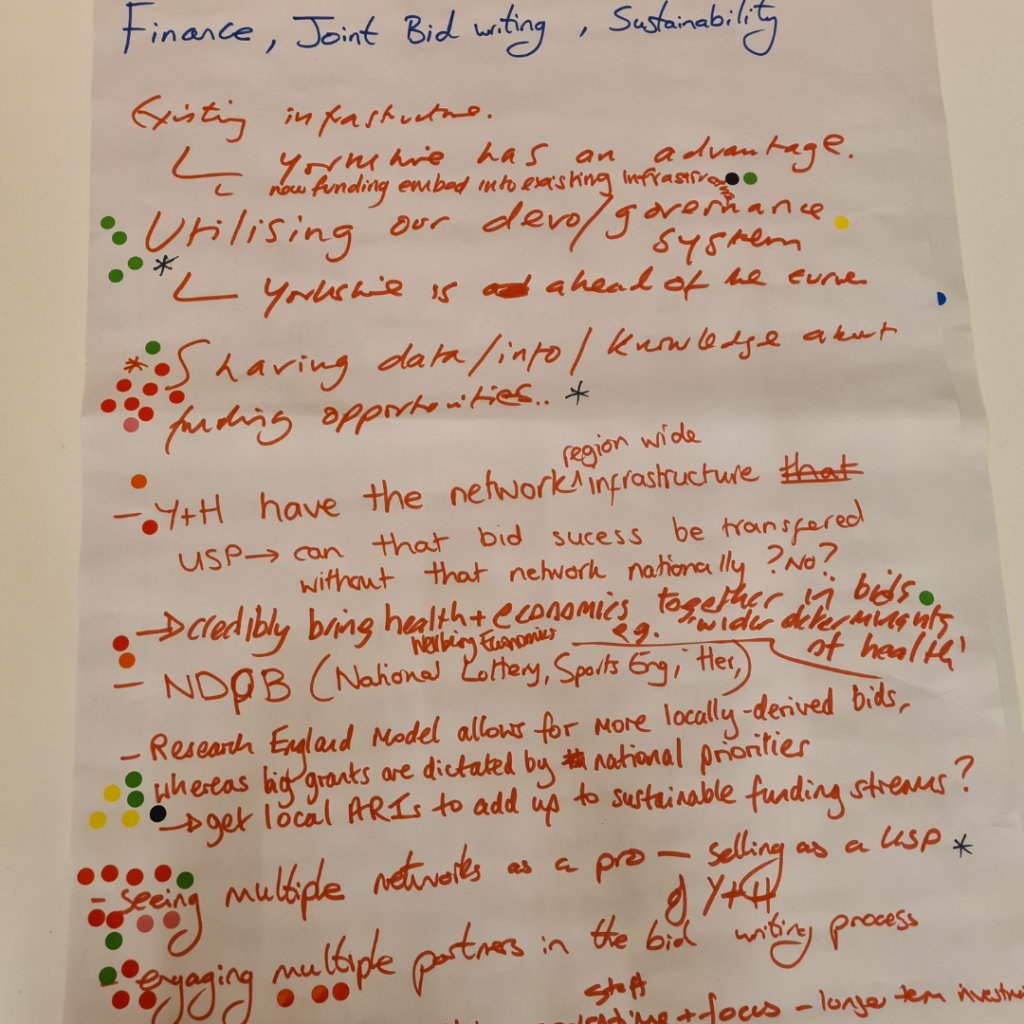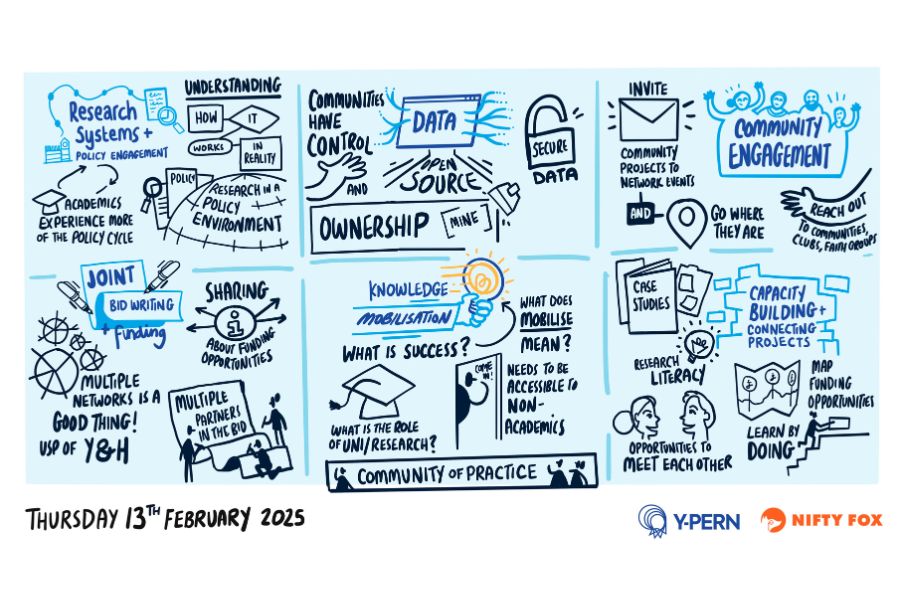Written by Kayleigh Renberg-Fawcett, Ella Howes, Jon Gleek and Kersten England CBE.
The Yorkshire & Humber is home paving the way for a more collaborative approach to place-based policy making. On the 13th of February, we brought together several of the Yorkshire & Humber focused networks – working between universities, communities and local policy (including local and combined authorities) – to explore how we could better work together.
Here we share some of our key takeaways:
For those not based in the Yorkshire & Humber, they’re often surprised by our stats; our population of 5.4 million residents is roughly equal to that of Denmark or Scotland, and our region is home to 12 universities – that’s roughly 38,000 staff (15,000 academics) and 220,000 students.
We’re also home to four combined authorities and 15 local authorities- making us a living lab of the current asymmetric nature of devolution. Each combined authority has been established at different time frames with differing powers – West Yorkshire Mayoral Combined Authority came on stream in 2014, and the Hull & East Yorkshire Mayoral Authority is due to elect its first Mayor in May 2025. This is an exciting time as we learn more about how decision-making is passed on locally, and how the new structures will impact evidence informed policy making.
This collective university and policy-based capacity in the region provides an opportunity for us to think more deeply about how we can work together on our local challenges – whether that be ageing population, early years childcare, poverty reduction, climate action or the government’s five missions.
And what makes this collective capacity feel meaningful is the spirit of collaboration in the region despite the testing times we’re in. This is largely underpinned by the Memorandum of Understanding between Yorkshire Universities and Yorkshire & Humber Councils.
Rudderless Mass or Solid Anchor?
There is in incredible wealth of activity taking place already between our regions universities and policy partners. This is often driven through short term funding, whether through UKRI or short-term funding cycles in local authorities (bring on the integrated settlements!) referred to as ‘rudderless mass of activity’, this can often feel disjointed or unconnected – a matter that is pertinent across the UK.
But what if we could create some regional legacy and memory of these activities; collectively review, learn and refine our ways of working, and build some coherence as to what good practice looks like for the region? Could we create ‘better’ research policy collaboration? Could we see more collaborations take place on the issues that concern us the most?
In the region, we are already anchored by a deep commitment to collaboration – the Yorkshire Universities/ Yorkshire & Humber Councils Memorandum of Understanding being one, our networked community of Yorkshire & Humber wide initiatives helping to join the dots being another, and our collective commitment as anchor institutions to bring value to the places we live and work in.
What collaboration could look like: A Yorkshire & Humber story – doing a lot with a little
On the 13th of February, we gathered at Doncaster’s Cast Theatre – next to the council building, to better get to know each other’s networks, identify the opportunities for deeper collaboration and identify priority next steps.

We heard from Yorkshire Universities (YU), the re-instated Yorkshire & Humber Councils Policy Forum, Yorkshire & Humber Policy Engagement & Research Network (Y-PERN), Yorkshire Policy Innovation Partnership (YPIP), Yorkshire Policy Collaboration (YPC), Yorkshire & Humber Health Determinant Research Collaboration network, Yorkshire & Humber Applied Research Collaboration (ARC) and the Yorkshire & Humber Climate Commission (YHCC).
We all learnt that we loved a Y acronym and have big ambitions. We also learnt that we need to do better in articulating our USPs externally – so we can advocate for each other, and our communities can better understand the opportunities to engage.
So, what can we do as a collective of networks, often operating on little, with a willingness to go beyond our own organisation’s remits?

We learnt that we are comfortable with the chaos, that a network approach is important to helping join the dots and that we’re committed to sharing with each other. We identified the need to strengthen our external comms and to share case studies of best practice. We also discussed how as a network we might be able to provide ‘end of life’ care support, as projects come and go – moving away from the risk that relationship and activities end once a project fundings ends.
We collectively identified the most urgent actions we thought needed addressing in the short term.
The urgent actions we identified were:
1. Speaking from the same hymn sheet:
Have a stronger communications and narrative that we can all speak to for our region so our partners can better understand what we do; and see this collective capability as a huge opportunity. As a network of networks, we will advocate, signpost and seek to join the dots.
2. Power of our communities
Ensuring we embed community engagement of research well and meaningfully in the development of research and policy activity. We have a wealth of experience across the region of doing this well, from the work of the Applied Research Collaborations, the HDRCs and newer initiatives like YPIP – as well as those beyond our networks. How do we create a connected learning loop.
3. Demystifying our organisations to enhance collaboration
Universities, local and combined authorities are complex, large organisations. Understanding the cultures, language and processes for academic policy engagement across local and combined authorities, and in universities is still a pressing priority so that we can identify sustainable, long-term solutions to collaboration. Emerging work in the region supporting the development of Areas of Research Interest across multilevel governance/in the context of devolution is an important opportunity for us to all learn from.
4. The need for intermediaries:
The importance of knowledge mobilisation! We recognised these were skills being developed across our networks, between different types of policy organisations, from NHS trusts, combined authorities, integrated care boards and local authorities. Coming together to share best practice will be invaluable to build our collective intermediary capacities.
5. Sustaining the connective infrastructure:
All the networks in the room were not funded by permanent architecture. We spoke of the challenge with navigating short-term funding, which is primarily used to support academic policy engagement. The risk of relationships, skillsets and capacities coming and going in the region was identified as a risk. This spoke to the importance of seeking to establish and push forward multi-university bids – recognising the diversity of the region, tapping into existing infrastructure and relationships, and ensuring opportunities are open to all. Suggestions included creating narrative statements for partners to speak to when applying for future funding.
6 Accessing data
Last but not least, was the important discussion of improving access to data to across our communities to help communities, policy makers and other partners make informed decisions. Excellent examples like the Born in Bradford infrastructure at the University of Bradford enabled local policy makers in Covid to engage with the local health data easily and rapidly. The YPIP programme is seeking to establish a Yorkshire & Humber Data Portal. And work with NHS trusts to establish a YH Secure Data Environment. If we can evaluate how these work in which context, and seek to continue to build on these formats, then we can start to make data more accessible.
Where to next?
The data identified a few co-leads for the themes above, led by attendees from the network. From communities of practice to case study development, to sharing opportunities to collaborate. Energised by the day’s discussion, the day was a helpful starting and clarifying point as to what the region needs and what we believe we can work collectively on in the near term.
Header image credit: Nifty Fox.



